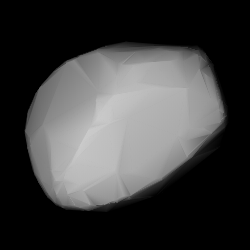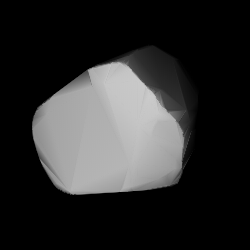
812 Adele is an elongated Eunomia asteroid from the central regions of the asteroid belt. It was discovered on 8 September 1915, by Russian astronomer Sergey Belyavsky at the Simeiz Observatory on the Crimean peninsula. The presumed S-type asteroid has a rotation period of 5.9 hours and measures approximately 13 kilometers in diameter. It was likely named after the character "Adele" in the opera Die Fledermaus by Johann Strauss.

1050 Meta, provisional designation 1925 RC, is a stony Eunomia asteroid from the central regions of the asteroid belt, approximately 10 kilometers in diameter. It was discovered on 14 September 1925, by German astronomer Karl Reinmuth at the Heidelberg Observatory in southwest Germany. The meaning of the asteroids's name is unknown. The presumably S-type asteroid has a rotation period of 6.14 hours and possibly an elongated shape.

1094 Siberia is an Eunomian asteroid from the central regions of the asteroid belt. It was discovered on 12 February 1926, by Soviet astronomer Sergey Belyavsky at the Simeiz Observatory on the Crimean peninsula. The X-type asteroid (Xk) has a rotation period of 21.2 hours and measures approximately 18 kilometers in diameter. It was named after the vast region of Siberia in North Asia.
1106 Cydonia, provisional designation 1929 CW, is a Eunomian asteroid from the central regions of the asteroid belt, approximately 13 kilometers in diameter. It was discovered on 5 February 1929, by astronomer Karl Reinmuth at the Heidelberg-Königstuhl State Observatory in Germany. The asteroid was named for the fruit-bearing tree Cydonia (quince). The S-type asteroid has a relatively short rotation period of 2.7 hours.
1168 Brandia, provisional designation 1930 QA, is a stony Eunomian asteroid from the central regions of the asteroid belt, approximately 10 kilometers in diameter. Discovered by astronomer Eugène Delporte at Uccle Observatory in 1930, the asteroid was later named after mathematician Eugène Brand.
1193 Africa, provisional designation 1931 HB, is a stony Eunomian asteroid from the central region of the asteroid belt, approximately 12 kilometers in diameter. It was discovered by South African astronomer Cyril Jackson at Johannesburg Observatory on 24 April 1931. The asteroid was named for the African continent.

5196 Bustelli is a stony Eunomia asteroid from the central regions of the asteroid belt, approximately 6 kilometers kilometers in diameter. It was discovered on 30 September 1973, by Dutch astronomers Ingrid and Cornelis van Houten at Leiden, and Tom Gehrels the Palomar Observatory. The S-type asteroid was named after Italian-Swiss artist Franz Anton Bustelli.
10830 Desforges, provisional designation 1993 UT6, is a background or Eunomian asteroid from the central regions of the asteroid belt, approximately 7 kilometers (4 miles) in diameter. It was discovered on 20 October 1993, by Belgian astronomer Eric Elst at the La Silla Observatory in northern Chile. The likely elongated S-type asteroid has a rotation period of 8.8 hours. It was named after French priest and aviation visionary Jacques Desforges.

2181 Fogelin is an Eunomia asteroid from the central regions of the asteroid belt, approximately 11 kilometers in diameter. It was discovered on 28 December 1942, by Germany astronomer Karl Reinmuth at the Heidelberg Observatory in southwest Germany. In 1980, it was named for Eric S. Fogelin an assistant at the Minor Planet Center. The likely elongated S-type asteroid has a rotation period of 14.07 hours.
3714 Kenrussell, provisional designation 1983 TT1, is a Eunomian asteroid from the central regions of the asteroid belt, approximately 10 kilometers (6 miles) in diameter. It was discovered on 12 October 1983, by American astronomer Edward Bowell at the Anderson Mesa Station near Flagstaff, Arizona, in the United States. It was named for Australian astronomer Kenneth S. Russell. The presumably stony asteroid has a rotation period of 5.25 hours.
1384 Kniertje, provisional designation 1934 RX, is a dark Adeonian asteroid from the central regions of the asteroid belt, approximately 26 kilometers in diameter. It was discovered on 9 September 1934, by Dutch astronomer Hendrik van Gent at the Union Observatory in Johannesburg, South Africa. The asteroid was named after a character in the Dutch play Op Hoop van Zegen by Herman Heijermans.
5542 Moffatt, provisional designation 1978 PT4, is a Marian asteroid from the central regions of the asteroid belt, approximately 9 kilometers (6 miles) in diameter. It was discovered on 6 August 1978, by astronomers at the Perth Observatory in Bickley, Australia. The likely S-type asteroid has a rotation period of 5.19 hours. It was named for Australian Ethelwin Moffatt, a benefactor of the discovering observatory.
1392 Pierre, provisional designation 1936 FO, is a dark, dynamical Eunomian asteroid from the central regions of the asteroid belt, approximately 26 kilometers (16 mi) in diameter. It was discovered on 16 March 1936, by astronomer Louis Boyer at the Algiers Observatory in Algeria, North Africa. The asteroid was named after the discoverer's nephew, Pierre.
1499 Pori, provisional designation 1938 UF, is a stony Eunomian asteroid from the central regions of the asteroid belt, approximately 15 kilometers in diameter. It was discovered on 16 October 1938, by Finnish astronomer Yrjö Väisälä at the Turku Observatory in southwest Finland. The asteroid was named after the Finnish city of Pori.

2384 Schulhof (prov. designation: 1943 EC1) is a mid-sized asteroid and the namesake of the Schulhof family, located in the Eunomian region of the intermediate asteroid belt. It was discovered on 2 March 1943, by French astronomer Marguerite Laugier at Nice Observatory in southeastern France. The asteroid was later named after Hungarian astronomer Lipót Schulhof. The presumed S-type asteroid has a short rotation period of 3.3 hours and measures approximately 12 kilometers (7.5 miles) in diameter.
1306 Scythia, provisional designation 1930 OB, is a dark Ursula asteroid from the outer regions of the asteroid belt, approximately 72 kilometers in diameter. It was discovered on 22 July 1930, by Soviet astronomer Grigory Neujmin at the Simeiz Observatory on the Crimean peninsula. The asteroid was named for the historic region of Scythia.
1425 Tuorla, provisional designation 1937 GB, is a stony Eunomian asteroid from the central regions of the asteroid belt, approximately 14 kilometers in diameter. It was discovered on 3 April 1937, by Finnish astronomer Kustaa Inkeri at the Iso-Heikkilä Observatory in Turku, southwestern Finland. The asteroid was named after the Tuorla Observatory of the University of Turku. It was Kustaa Inkeri's only asteroid discovery.
4085 Weir, provisional designation 1985 JR, is a stony Eunomian asteroid from the central regions of the asteroid belt, approximately 10 kilometers in diameter. It was discovered on 13 May 1985, by astronomer Carolyn Shoemaker at the Palomar Observatory in California, United States. The asteroid was named after American geologist Doris Blackman Weir.
5855 Yukitsuna, provisional designation 1992 UO2, is a stony Marian asteroid from the central regions of the asteroid belt, approximately 11 kilometers (7 miles) in diameter. It was discovered on 26 October 1992, by Japanese astronomers Akira Natori and Takeshi Urata at the JCPM Yakiimo Station. The likely elongated S-type asteroid has a rotation period of 19 hours. It was named for Minamoto no Yukitsuna, a Japanese general during the Heian era.
2672 Písek, provisional designation 1979 KC, is a Eunomia asteroid from the central regions of the asteroid belt, approximately 25 kilometers in diameter. It was discovered on 31 May 1979, by Yugoslav astronomer Jaroslav Květoň at the Kleť Observatory in the Czech Republic. The likely elongated asteroid is a suspected tumbler and a slow rotator with an exceptionally long period of 831 hours. It was named after the Czech town of Písek.






